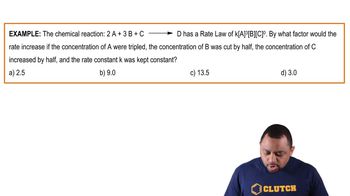A reaction in which A, B, and C react to form products is first order in A, second order in B, and zero order in C c. By what factor does the reaction rate change if [A] is doubled (and the other reactant concentrations are held constant)? d. By what factor does the reaction rate change if [B] is doubled (and the other reactant concentrations are held constant)? e. By what factor does the reaction rate change if [C] is doubled? f. By what factor does the reaction rate change if the concentrations of all three reactants are doubled?
Ch.14 - Chemical Kinetics
Chapter 14, Problem 40c,d,e,f
A reaction in which A, B, and C react to form products is zero order in A, one-half order in B, and second order in C. c. By what factor does the reaction rate change if [A] is doubled (and the other reactant concentrations are held constant)? d. By what factor does the reaction rate change if [B] is doubled? e. By what factor does the reaction rate change if [C] is doubled? f. By what factor does the reaction rate change if [C] is doubled (and the other reactant concentrations are held constant)?
 Verified step by step guidance
Verified step by step guidance1
Identify the rate law expression for the reaction: \( \text{Rate} = k[A]^0[B]^{1/2}[C]^2 \).
Recognize that the reaction is zero order in A, meaning changes in [A] do not affect the rate.
Understand that the reaction is one-half order in B, meaning the rate is proportional to the square root of [B].
Note that the reaction is second order in C, meaning the rate is proportional to the square of [C].
Calculate the factor by which the rate changes when [C] is doubled: \( \left(2[C]\right)^2 = 4[C]^2 \), so the rate increases by a factor of 4.

Verified video answer for a similar problem:
This video solution was recommended by our tutors as helpful for the problem above.
Was this helpful?
Key Concepts
Here are the essential concepts you must grasp in order to answer the question correctly.
Order of Reaction
The order of a reaction refers to the power to which the concentration of a reactant is raised in the rate law. It indicates how the rate of reaction is affected by the concentration of that reactant. In this case, the reaction is zero order in A, one-half order in B, and second order in C, meaning that changes in the concentration of A do not affect the rate, while B and C do, with C having the most significant impact.
Recommended video:
Guided course

Average Bond Order
Rate Law
The rate law expresses the relationship between the rate of a chemical reaction and the concentrations of its reactants. It is typically written in the form Rate = k[A]^m[B]^n[C]^p, where k is the rate constant, and m, n, and p are the orders of the reaction with respect to each reactant. For this reaction, the rate law can be expressed as Rate = k[B]^(1/2)[C]^2, highlighting how the rate depends on the concentrations of B and C.
Recommended video:
Guided course

Rate Law Fundamentals
Effect of Concentration Change on Reaction Rate
When the concentration of a reactant is changed, the reaction rate changes according to its order. For example, if the concentration of C is doubled in this reaction, the rate will increase by a factor of 2^2 (since C is second order), resulting in a fourfold increase in the reaction rate. This principle is crucial for predicting how changes in reactant concentrations will affect the overall speed of the reaction.
Recommended video:
Guided course

Concentration Changes and Rate Law Example
Related Practice
Textbook Question
Textbook Question
A reaction in which A, B, and C react to form products is zero order in A, one-half order in B, and second order in C. a. Write a rate law for the reaction.
Textbook Question
Consider the tabulated data showing the initial rate of a reaction (A → products) at several different concentrations of A. What is the order of the reaction? Write a rate law for the reaction including the value of the rate constant, k.
